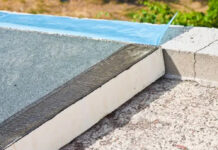Normally low pitched roofs sit in a difficult position. All pitched roofs generally have tiles, however with a low pitch there may be insufficient gravity working on the rainwater to get it down the tiles before it finds its way into a gap in the tiles. This can begin to overwhelm the felt underlay in the worst scenario.
That’s where Permavent’s Plain Easy is at its most useful, however. Plain Easy is a revolutionary product that allows plain tiles to be used at low pitches without fear of water penetration. These sheets go underneath courses of tiles and allow tiles intended for pitches as high as 35 degrees be used at pitches as low as 17.5 degrees.
Plain easy is easiest to install when a tiled roof is already being installed. You can install it on an already existing roof if you’re having issues with water penetration and think it will help. However, it will require significant investments of time since the entire tiled roof will need to be removed and then replaced.
You should not try to install Plain Easy by yourself if you are not totally comfortable working on scaffolding. You will need to use scaffolding if you’re installing Plain Easy since you’ll be at the very least installing the plain tiles. If you don’t have professional level confidence it’s best to hire professionals to perform this installation for you.
Also note that Plain Easy should be used only on a roof that already has a breather membrane, meaning that Plain Easy should only be used on “warm roof” solutions.
You will need:
- Safety gloves and safety goggles
- Enough plain easy for the entire roof in question
- Scaffolding
- Copper nails fit for plain tiles, enough for two per tile.
- Claw hammer
- Self-adhesive flashing (if abutments are involved)
- Roof Sealant
- Utility Knife
Installing Plain Easy
If your roof has the tiles on it, you will need to remove them first. Then, you should lay the first course of tiles. Then the plain easy should be laid on top of it. While nailing the next course, make sure to drive through the plain tile into the Plain Easy into the batten. This will allow the tiles to secure the Plain Easy. After laying the second course of tiles, repeat this process till you are at the ridge, then do the same on the other side. The actual ridge tiles do not need Plain Easy strips.
Whenever strips of Plain Easy need to overlap they should overlap by 75mm. You will need to cut a corner off of one of the strips that is 15mm wide and 75mm long (lengthways) using a utility knife. This will prevent it from raising up the next tile up. A bead of sealant should be used to seal this overlap.
If the Plain Easy runs next to an abutment you should use self-adhesive flashing to form soakers over the Plain Easy strips. Place the tiles over both the Plain Easy and the flashing. This will lock it in place.






